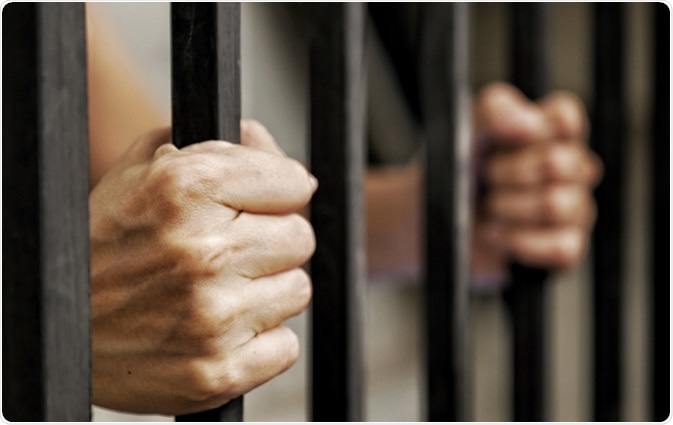Anxiety is a feeling of worry, nervousness, or fear that often comes when a person’s body responds to a critical or frightening situation. In this condition, the body prepares for an action, i.e., to fight against the threat or run away from it. When our mind prepares to cope with the threat, our body shows some physical symptoms, which vary based on the type of anxiety.
This is a common problem in people, especially among those sentenced to imprisonment. A study by the Ministry of Justice found that 23% of male and 49% of female prisoners suffer from depression and anxiety.

Image Credit: karanik yimpat / Shutterstock
Causes of Prisoner Anxiety
There can be numerous causes that make a prisoner anxious, some of which are:
Crime: The prisoner perpetually thinks about the crime he has committed and feels worry or guilt, leading to mental stress.
Place: Prisoners are bound to a restricted space and are separated from their loved ones; this isolation makes them feel strongly about their loss of freedom, and thus they are pushed into a world of stress and depression.
People: They are surrounded by other prisoners who may be unpredictable and of violent character or behavior; this creates fear leading to anxiety.
Prolonged imprisonment: In addition to the above, persons who undergo frequent or continuous imprisonments are affected by psychological conditions. They brood about what society might have to say about their term; this increases the risk levels for development of major stress or mental illness.
Poverty, substance abuse, unemployment, lack of early intervention, mental health services in the community are also factors that cause mental illness among prisoners. Some intrinsic causes such as effects of incarceration, role of the police, and role of sentencing also affect the mental health of inmates.
Anxiety Symptoms in Prisoners
Some anxiety symptoms that are exhibited by prisoners are as follows:
- Whenever the prison door opens or closes, the inmates are perturbed and feel stressed.
- They are angry and testy, and always at the edge, expecting something untoward to happen.
- Without any reason, sometimes they feel that they are going mad or losing control.
- They feel sweaty and have difficulty in breathing, along with sleep problems.
- Stressful concerns such as deprivation, uselessness, changes in behavior, etc., are seen in persons who go to prison or court.
- While prisoners wait for a visitor or for mail, they feel a tightness in their throat and mouth and which subsequently become dry.
These symptoms, unless understood properly by the prisoner will in no way help him to overcome the anxiety that he experiences; in fact, they may worsen his condition.
Diagnosis
If the above symptoms are found in the inmates of a prison, their medical history should be examined by the physician to confirm the presence of anxiety. There are no other lab tests that can ratify or diagnose the disorder.
Treatment
Anxiety in a prisoner is treatable; the treatment may be complex if the person has more than one anxiety, or has substance abuse. Therefore, the processes involved are specifically personalized for each individual. Some standard methods of treatment have also proved effective. Such methods include therapies as well as medications.
Cognitive Behavioral Therapy
A commonly used solution-oriented and combined therapy is cognitive behavioral therapy (CBT). Negative and diverse patterns in the manner a person looks at themself as well as the world are addressed in this therapy. It concentrates more on identifying, analyzing, understanding, and altering the thinking and behavior patterns of the patient.
This therapy involves two main components:
- Cognitive therapy: Examines factors such as negative thoughts or cognitions.
- Behavior therapy: Examines how one behaves and reacts in situations.
The patient actively participates in this therapy and learns skills that are useful for self-recovery. Learning about the problems, maintenance of consultation records, doing homework assignments, etc., are the tasks they involve in.
To improve using CBT, patients must continuously practice the skills that they learn during therapy sessions. Based on the individual, the benefits of this therapy in prisoners are usually seen by 12–16 weeks.
Medication
Medications for anxiety are usually safe and effective, and are frequently used along with the therapies. Based on the severity of the symptoms, the period of medication varies from short-term to long-term. However, it usually takes some time for the drug to work better in patients, if taken as instructed by the physician.
Medication for anxiety usually includes antidepressants and sedatives that are prescribed based on the severity of the symptoms.
Self-Help
In many cases, the prisoner themself can treat their condition of anxiety in a variety of ways, such as by practicing meditation, physical exercises, resting in a dark room, or talking with sympathetic persons.
The rate of success of treatment varies, as some may respond to treatment within a few weeks or months, while others may need more than a year.
Further Reading
Last Updated: Dec 29, 2022